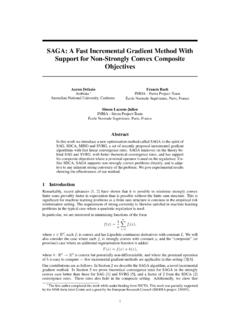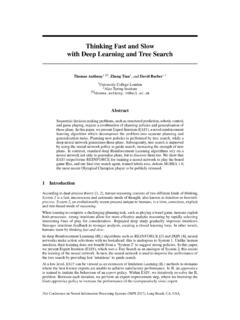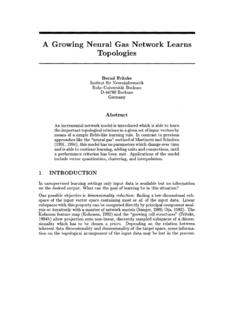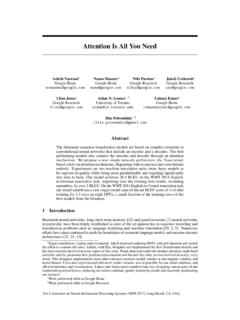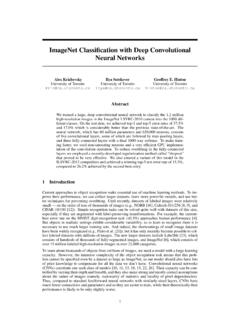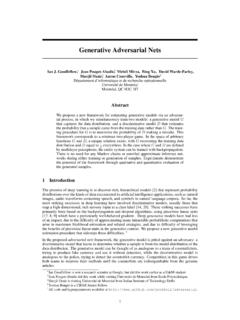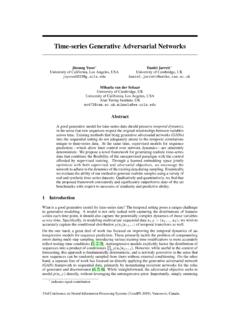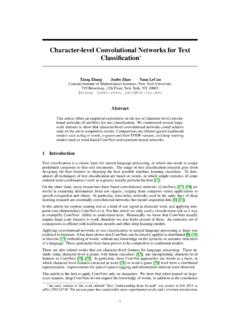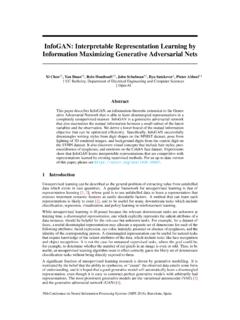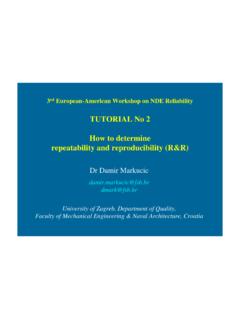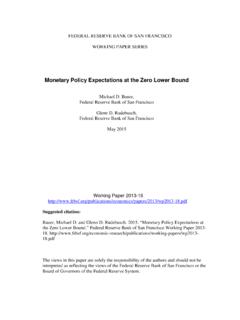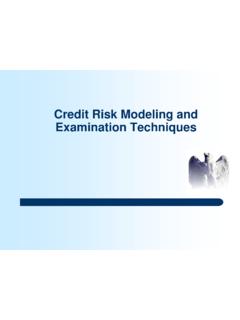Transcription of On Discriminative vs. Generative Classifiers: A …
1 On Discriminative vs. Generative classifiers: A comparison of logistic regression and naive Bayes Andrew Y. Ng Computer Science Division University of California, Berkeley Berkeley, CA 94720 Michael I. Jordan Div. & Dept. of Stat. University of California, Berkeley Berke ley, CA 94720 Abstract We compare Discriminative and Generative learning as typified by logistic regression and naive Bayes. We show, contrary to a widely-held belief that Discriminative classifiers are almost always to be preferred, that there can often be two distinct regimes of per-formance as the training set size is increased, one in which each algorithm does better.
2 This stems from the observation-which is borne out in repeated experiments-that while Discriminative learning has lower asymptotic error, a Generative classifier may also approach its (higher) asymptotic error much faster. 1 Introduction Generative classifiers learn a model of the joint probability, p( x, y), of the inputs x and the label y, and make their predictions by using Bayes rules to calculate p(ylx), and then picking the most likely label y. Discriminative classifiers model the pos-terior p(ylx) directly, or learn a direct map from inputs x to the class labels. There are several compelling reasons for using Discriminative rather than Generative clas-sifiers, one of which, succinctly articulated by Vapnik [6], is that "one should solve the [classification] problem directly and never solve a more general problem as an intermediate step [such as modeling p(xly)].
3 " Indeed, leaving aside computational issues and matters such as handling missing data, the prevailing consensus seems to be that Discriminative classifiers are almost always to be preferred to Generative ones. Another piece of prevailing folk wisdom is that the number of examples needed to fit a model is often roughly linear in the number of fr ee parameters of a model. This has its theoretical basis in the observation that for "many" models, the VC dimension is roughly linear or at most some low-order polynomial in the number of parameters (see, , [1, 3]), and it is known that sample complexity in the Discriminative setting is linear in the VC dimension [6].
4 In this paper, we study empirically and theoretically the extent to which these beliefs are true. A parametric family of probabilistic models p(x, y) can be fit either to optimize the joint likelihood of the inputs and the labels, or fit to optimize the conditional likelihood p(ylx), or even fit to minimize the 0-1 training error obtained by thresholding p(ylx) to make predictions. Given a classifier hGen fit according to the first criterion, and a model hDis fit according to either the second or the third criterion (using the same parametric family of models), we call hGen and hDis a Generative - Discriminative pair.
5 For example, if p(xly) is Gaussian and p(y) is multinomial, then the corresponding Generative - Discriminative pair is Normal Discriminant Analysis and logistic regression . Similarly, for the case of discrete inputs it is also well known that the naive Bayes classifier and logistic regression form a Generative - Discriminative pair [4, 5]. To compare Generative and Discriminative learning, it seems natural to focus on such pairs. In this paper, we consider the naive Bayes model (for both discrete and continuous inputs) and its Discriminative analog, logistic regression /linear classifi-cation, and show: (a) The Generative model does indeed have a higher asymptotic error (as the number of training examples becomes large) than the Discriminative model, but (b) The Generative model may also approach its asymptotic error much faster than the Discriminative model-possibly with a number of training examples that is only logarithmic, rather than linear, in the number of parameters.
6 This suggests-and our empirical results strongly support-that, as the number of train-ing examples is increased, there can be two distinct regimes of performance, the first in which the Generative model has already approached its asymptotic error and is thus doing better, and the second in which the Discriminative model approaches its lower asymptotic error and does better. 2 Preliminaries We consider a binary classification task, and begin with the case of discrete data. Let X = {O, l}n be the n-dimensional input space, where we have assumed binary inputs for simplicity (the generalization offering no difficulties).
7 Let the output labels be Y = {T, F}, and let there be a joint distribution V over X x Y from which a training set S = {x(i) , y(i) }~1 of m iid examples is drawn. The Generative naive Bayes classifier uses S to calculate estimates p(xiIY) and p(y) of the probabilities p(xiIY) and p(y), as follows: P' (x-= 11Y = b) = #s{xi=l,y=b}+1 (1) , #s{y-b}+21 (and similarly for p(y = b),) where #s{-} counts the number of occurrences of an event in the training set S. Here, setting l = corresponds to taking the empirical estimates of the probabilities, and l is more traditionally set to a positive value such as 1, which corresponds to using Laplace smoothing of the probabilities.
8 To classify a test example x, the naive Bayes classifier hGen : X r-+ Y predicts hGen(x) = T if and only if the following quantity is positive: (rr~-d)(xily = T))p(y = T) ~ p(xilY = T) p(y = T) IGen( x ) = log (rrn ' ( _I _ F))'( _ F) = ,log ' ( _I _ F) + log ' ( _ F)' (2) i=1 P X, Y -P Y -i=1 P X, Y -P Y -In the case of continuous inputs, almost everything remains the same, except that we now assume X = [O,l]n, and let p(xilY = b) be parameterized as a univariate Gaussian distribution with parameters {tily=b and if; (note that the j1's, but not the if's, depend on y). The parameters are fit via maximum likelihood, so for example {tily=b is the empirical mean of the i-th coordinate of all the examples in the training set with label y = b.}}
9 Note that this method is also equivalent to Normal Discriminant Analysis assuming diagonal covariance matrices. In the sequel, we also let = E[XiIY = b] and a; = Ey[Var(xily)] be the "true" means and variances (regardless of whether the data are Gaussian or not). In both the discrete and the continuous cases, it is well known that the discrimina-tive analog of naive Bayes is logistic regression . This model has parameters [,8, OJ, and posits that p(y = Tlx;,8,O) = 1/(1 +exp(-,8Tx -0)). Given a test example x, the Discriminative logistic regression classifier hois : X I-t Y predicts hOis (x) = T if and only if the linear discriminant function lDis(x) = L~=l (3ixi + () (3) is positive.)]
10 Being a Discriminative model, the parameters [(3, ()] can be fit either to maximize the conditionallikelikood on the training set L~=llogp(y(i) Ix(i); (3, ()), or to minimize 0-1 training error L~=ll{hois(x(i)) 1-y(i)}, where 1{-} is the indicator function (I{True} = 1, I{False} = 0). Insofar as the error metric is 0-1 classification error, we view the latter alternative as being more truly in the "spirit" of discrim-inative learning, though the former is also frequently used as a computationally efficient approximation to the latter. In this paper, we will largely ignore the differ-ence between these two versions of Discriminative learning and, with some abuse of terminology, will loosely use the term " logistic regression " to refer to either, though our formal analyses will focus on the latter method.))
